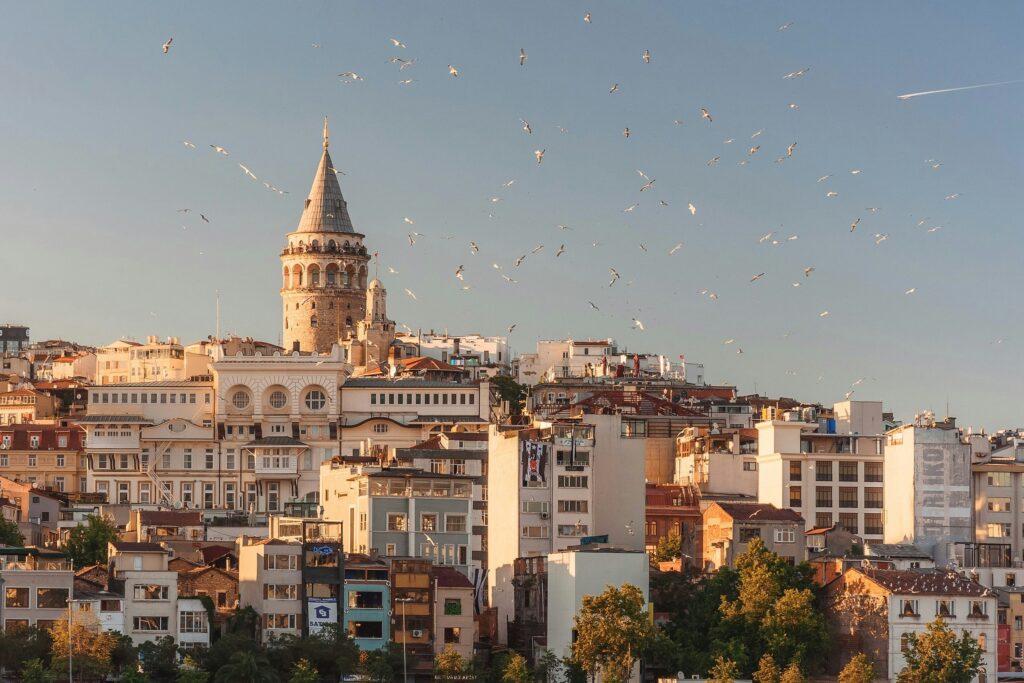
Research and knowledge are the first steps for Angola Travel Business Assistance. Here is a fact file for Angola to get you started. Contact us if you are looking to start a business in or expand your market to Angola. We have consultants ready to help you on the ground in Angola.
Discover new markets with ease – Book your free consultation with Travel Business Assistance now.
Basics Facts About Turkey
Origin of the name
The name “Turkey” for the country originates from the people who inhabit it – the Turks. The term traces back to the Medieval Latin words “Turchia” or “Turquia,” which literally translates to “land of the Turks.” This connection appears in English writings as early as the 14th century, with Geoffrey Chaucer referencing “Turkye” in his work “The Book of Duchess” around 1369. The term continued to evolve through Middle English with variations like “Turkie” and “Turky,” eventually settling on the modern spelling “Turkey” by the 18th century. Interestingly, the Turkish government itself has recently advocated for using “Türkiye” internationally, as it’s seen as a more accurate representation of the country’s culture and heritage.
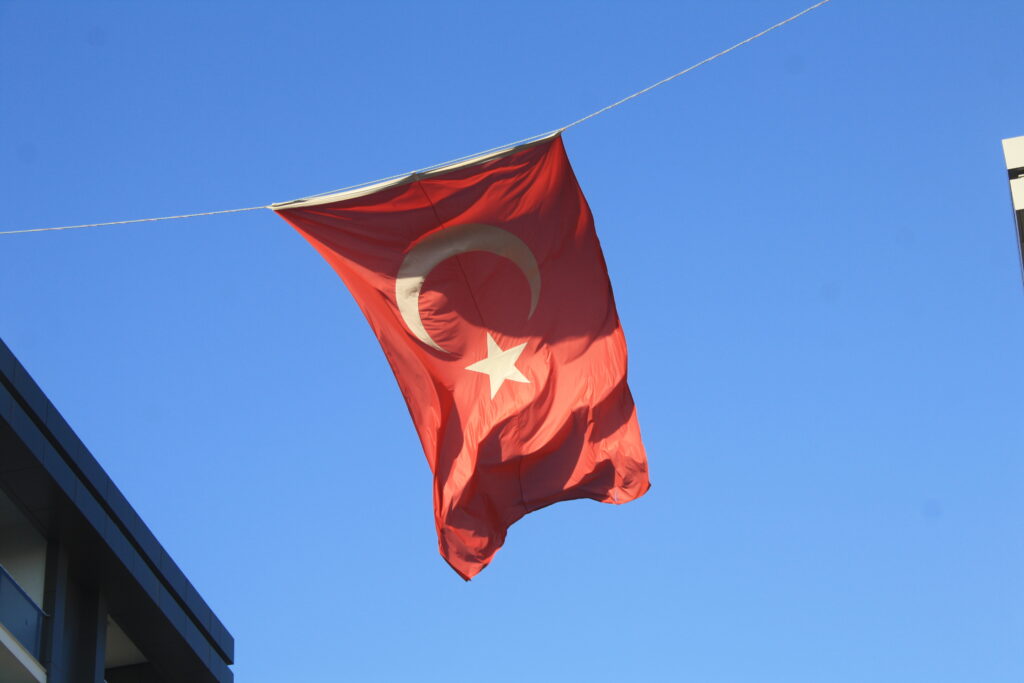 The Turkish Flag
The Turkish Flag
The national flag of Turkey, also referred to as “the red flag” or “the red banner” in the Turkish national anthem, is a simple yet powerful design. It features a bright red background with a centred white crescent moon and star. The red is a vivid shade, and the proportions of the flag are two units wide to three units long. Interestingly, the specific shade of red and the exact dimensions of the flag were officially established by law in 1936, known as the Turkish Flag Law.
The symbolism of the flag’s elements is open to interpretation. The crescent moon and star have been used for centuries by various cultures, and their specific meaning in the Turkish flag is debated. Some believe they represent Islam, while others see them as older symbols with broader meanings. Regardless of the interpretation, the Turkish flag is a recognizable symbol that evokes feelings of patriotism and national pride.
Capital City of Turkey
The capital of Turkey is Ankara, situated in the central Anatolian region. Though not the largest city in Turkey (that distinction belongs to Istanbul), Ankara holds significant historical and political weight. Established as the capital upon the founding of the Republic of Turkey in 1923, Ankara played a pivotal role in the new nation’s separation from the Ottoman Empire.
Ankara is a thriving metropolis with a population exceeding 5 million. The city boasts a rich cultural heritage, evident in its historical landmarks like the imposing Ankara Castle and the exquisite Kocatepe Mosque. Ankara is also a major commercial and industrial hub, benefiting from its central location within Turkey’s transportation network. With a strong government presence and a flourishing economy, Ankara serves as the heart of modern Turkey.
History & Independence
Early Civilizations (B.C.E.)
- 18th-13th centuries B.C.E.: The Hittite Empire, a powerful civilization, flourishes in Anatolia (Asia Minor), laying the groundwork for future cultures.
- 1950 B.C.E. onwards: Assyrians conquer and settle parts of southeastern Turkey.
- 6th century B.C.E.: Various kingdoms and empires rise and fall in Anatolia, including Phrygia, Lydia, and Caria.
- 546 B.C.E.: The Achaemenid Empire of Persia conquers all of Anatolia.
- 334 B.C.E.: Alexander the Great conquers Anatolia, ushering in a period of Hellenistic influence.
Roman and Byzantine Rule (B.C.E. – 1453 C.E.)
- 1st century B.C.E.: The Roman Empire takes control of Anatolia.
- 330 C.E.: The Roman Empire becomes Christianized and eventually splits into Eastern and Western Roman Empires. Anatolia falls under the Eastern Roman Empire, also known as the Byzantine Empire.
Rise of the Turks and the Ottoman Empire (11th – 19th Centuries C.E.)
- 11th century C.E.: Turkic tribes from Central Asia begin migrating into Anatolia.
- 1299 C.E.: Osman I establishes the Ottoman Empire in northwestern Anatolia.
- 1453 C.E.: The Ottomans conquer Constantinople (present-day Istanbul), marking the end of the Byzantine Empire. The Ottoman Empire becomes a major world power.
Turkey’s Transformation: 1900 – Present
Turkey’s 20th and 21st centuries have been marked by a dramatic shift from a vast empire to a modern republic. Here’s a breakdown by period:
- Fall of the Ottomans (1900-1923):
- Leaders: Various Sultans (Abdul Hamid II, Mehmed V, Mehmed VI)
- Context: The Ottoman Empire, once a powerful force, weakened significantly by the turn of the 20th century. Internal struggles, economic woes, and rising nationalism in subject territories chipped away at its foundation.
- Key Events:
- 1908: The Young Turk Revolution led to a brief period of constitutional monarchy.
- 1914-1918: The Ottomans sided with Germany in World War I, ultimately suffering a devastating defeat. The Treaty of Sèvres (1920) imposed harsh terms, carving up the empire.
- Rise of the Republic (1923-1945):
- Leader: Mustafa Kemal Atatürk (1923-1938)
- Context: Mustafa Kemal Atatürk, a military leader, emerged as a national hero during the Greco-Turkish War (1919-1922). He rejected the Treaty of Sèvres and led the Turkish War of Independence.
- Key Events:
- 1922: Abolition of the Ottoman Sultanate and establishment of the Republic of Turkey.
- 1923: Treaty of Lausanne replaces Treaty of Sèvres, defining modern Turkey’s borders.
- 1924: Caliphate abolished, separation of religion and state.
- 1930s: Atatürk institutes sweeping reforms to modernize Turkey:
- Westernization: Shift from Arabic script to Latin alphabet, adoption of Western clothing, secularization of society.
- Women’s rights: Increased freedoms for women, including voting rights in 1934.
- Early Multi-Party Period (1945-1980):
- Leaders: Various presidents and prime ministers
- Context: After Atatürk’s death, Turkey transitioned to a multi-party system. The period saw economic development efforts and a cautious approach to foreign policy.
- Key Events:
- 1952: Turkey joins NATO, aligning with the West during the Cold War.
- 1974: Turkish military intervention in Cyprus due to a coup aiming for unification with Greece.
- 1970s: Growing political instability and economic difficulties.
- Military Coups and Kurdish Conflict (1980-2002):
- Leaders: Military juntas (1980 coup, 1997 coup) and civilian governments
- Context: Political unrest and economic crisis led to military coups in 1980 and 1997. The period also saw the escalation of the Kurdish conflict in southeastern Turkey.
- Key Events:
- 1980: Military coup d’état, followed by a period of repression and a new constitution.
- 1984: PKK (Kurdistan Workers’ Party) insurgency intensifies.
- 1997: Second military coup, aiming to curb Islamist influence.
- AKP Era and EU Aspirations (2002-Present):
- Leaders: Recep Tayyip Erdoğan (Prime Minister 2003-2014, President 2014-present)
- Context: The Justice and Development Party (AKP) led by Erdoğan came to power in 2002, ushering in a period of economic growth and political stability. Turkey has also pursued closer ties with the European Union.
- Key Events:
- 2002-2010: Strong economic growth under the AKP government.
- Ongoing: Negotiations for EU membership continue, although progress has stalled in recent years.
- 2016: Failed coup attempt leads to a crackdown on dissent and a shift towards a more authoritarian system.
Government
Turkey operates as a presidential representative democracy within a constitutional republic. This means power is divided between three main branches: the executive, legislative, and judicial. The executive branch is headed by the President, who also acts as the head of state and government. The President leads the Cabinet, which is similar to a council of ministers, and appoints its members. Legislative power rests with the unicameral Grand National Assembly. This body is responsible for passing laws, approving budgets, and declaring war. The final branch is the judiciary, which is supposed to be independent of both the executive and legislative branches. The current Turkish Constitution was adopted in 1982 and has been amended several times since.
Language
Official Language
The official language of Turkey is Turkish, also known as Istanbul Turkish or Türkiye Türkçesi. Belonging to the Turkic language family, it boasts around 90 to 100 million speakers worldwide, making it the most widely spoken Turkic language. Interestingly, Turkish utilizes the Latin alphabet, a stark contrast to the Arabic script used historically. This change occurred during the founding of the Republic of Turkey to foster national unity and establish a common written language. While Turkish reigns supreme as the official language, a rich tapestry of over 70 other languages and dialects colors the linguistic landscape of Turkey, including Kurdish, Arabic, and Armenian.
Business Culture
Turkish business culture offers a unique blend of tradition and modernity. Building relationships is key, and expect initial meetings to be formal occasions focused on getting to know each other and establishing trust. Patience is appreciated, as decisions can take time. Turkish businesspeople are generally very hospitable and professional, and they value foreign partners who dress appropriately, act politely, and demonstrate cultural sensitivity.
Hierarchy is important, and titles are respected. Meetings may start with small talk and tea, and it’s best to avoid scheduling them during prayer times or religious holidays. While punctuality is valued, being a few minutes late with a good excuse is usually acceptable. The dress code leans towards conservative business attire, with lighter options permissible in warmer months.
Remember, Turkish business culture is both international and traditional. While English is common, especially in larger cities, making an effort to learn a few basic Turkish phrases goes a long way. By understanding these aspects, you’ll be well on your way to fostering successful business relationships in Turkey.
Turkey Demography:
Turkey boasts a population of over 86 million, ranking 18th globally. The majority, around 77%, reside in urban areas. Interestingly, despite a youthful overall demographic with a median age of 31.8, Turkey is experiencing a shift. The birth rate sits slightly below the world average, while the population ages. This is reflected in the declining percentage of children (0-14 age group) and a rise in the elderly (over 65 age group). Ethnically, Turks are the dominant group, and Islam is the primary religion. Turkey has also witnessed internal migration trends, with people moving from rural areas to urban centres for opportunities. Literacy rates are high, exceeding 95% for both men and women.
Time Zone
Turkey observes a single time zone throughout the country, Eastern European Time (EET), which is UTC+3. This means that Turkey is three hours ahead of Coordinated Universal Time (UTC) and currently shares the same time zone with countries like Bulgaria, Finland, and Russia (western part). It’s important to note that Turkey does not daylight-saving time (DST). Therefore, the time difference between Turkey and other countries can vary depending on whether they are observing DST at a particular time of year.
The Climate
Turkey boasts a diverse climate due to its unique geographic location bridging the temperate and subtropical zones. To fully understand the country’s weather patterns, a climate map would reveal several distinct regions:
- Mediterranean Coast: This southern region basks in a classic Mediterranean climate, characterized by hot, dry summers with average temperatures ranging from 20-25°C (68-77°F). Winters are mild and rainy, with temperatures hovering around 2-6°C (36-43°F). Rainfall here is moderate, averaging between 600-1,100 millimeters (24-43 inches) annually.
- Black Sea Coast: The northern coastline experiences a cooler, wetter climate compared to the Mediterranean. Summers are warm, with average temperatures around 20-25°C (68-77°F), but winters are milder with occasional snow. Precipitation is more abundant here, with frequent rain and occasional snowfall throughout the year.
- Interior Anatolia: As you move inland, the climate transitions to a continental one. Summers get hotter, with temperatures exceeding the coastal regions, while winters become colder with significant snowfall. This region experiences larger temperature swings between day and night, and overall receives less rainfall compared to the coasts.
- Marmara Region: Located in northwestern Turkey, this area exhibits a transitional climate, blending characteristics of the Mediterranean, Black Sea, and continental climates. You’ll find warm summers, mild winters with some snowfall, and moderate rainfall throughout the year.
Turkish Boarders
Turkey, with its unique transcontinental location, boasts a diverse range of bordering regions. The Black Sea forms its northern boundary, while Georgia, Armenia, Azerbaijan, and Iran lie to the east. Iraq and Syria occupy the southeastern region, with the Mediterranean Sea and Cyprus situated to the south. To the west, Turkey borders the Aegean Sea, Greece, and Bulgaria. Interestingly, the Sea of Marmara and the Turkish Straits (Bosporus and Dardanelles) separate the Asian and European portions of Turkey, contributing to its cultural richness. The total length of Turkey’s borders reaches around 4,000 miles, with a significant portion being maritime borders along the Black, Aegean, and Mediterranean Seas. These straits hold strategic importance as they control the only passage from the Black Sea. Land borders, established through treaties like the Treaty of Lausanne (1923), stretch for over 1,000 miles and are well-defined with all eight neighboring countries.
Size of Turkey
Turkey’s total land area is approximately 783,562 square kilometres (302,535 square miles). This measurement places Turkey as the 37th largest country globally and one of the largest countries located in Asia. For reference, Turkey is more than twice the size of Germany and slightly smaller than the combined areas of the U.S. states of Texas and Louisiana.
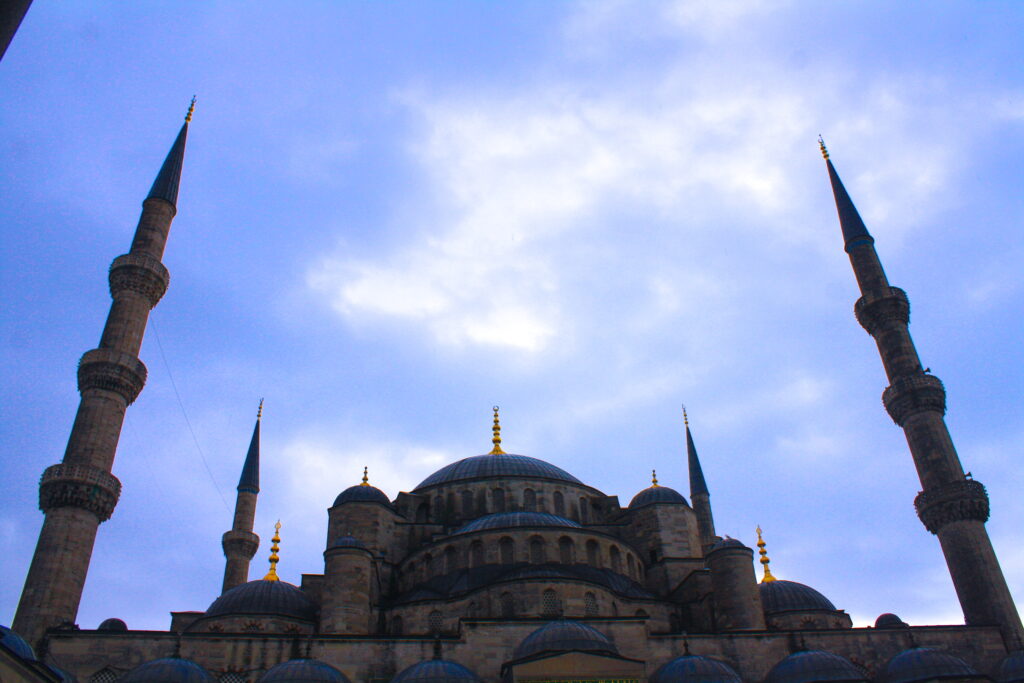 Religion
Religion
Turkey’s religious landscape is predominantly Islamic, with the government reporting 99% of the population as Muslim. However, within Islam itself exists a rich diversity. The vast majority, around 90%, adhere to Sunni Islam, following the Hanafi school of jurisprudence. Notably, Turkey is a secular state with no official religion, established by its constitution in 1924. There’s also a significant Alevi community, estimated to be between 10% and 30% of the population. Alevism is a heterodox branch of Islam with unique beliefs and practices, sometimes considered a form of Shia Islam. Smaller groups like Bektashis, a Sufi order, also contribute to the religious tapestry of Turkey. While Christianity and Judaism are present, their numbers are much smaller. It’s important to remember that official statistics on religion in Turkey can vary depending on the source, with some surveys suggesting a higher percentage of non-religious individuals.
Turkish Currency
The official currency of Turkey is the Turkish Lira, denoted by the symbol ₺ (TRY according to ISO 4217 code). One Turkish Lira is divided into 100 kuruş, though kuruş are rarely used in daily transactions. The Lira was introduced in 1844, and underwent a redenomination in 2005 due to inflation. Prior to 2012, TL was used as the abbreviation for Lira, but a symbol contest resulted in the current unique design. Turkish Lira is the sole currency for domestic transactions in Turkey, and is also used in the Turkish Republic of Northern Cyprus and parts of northern Syria.
- Exchange Rate Dynamics
The Turkey ‘s exchange rate against major currencies experiences fluctuations. As of today (23/03/24), 1 GBP is equivalent to approximately ₺ 40,34.
https://www.xe.com/currencyconverter/convert/?Amount=1&From=GBP&To=TRY
Practical Tips for Using Turkey Lira
Currency:
- Preferred: Always try to tip in Turkish Lira whenever possible. This ensures the server receives the full amount without any exchange hassles.
- Alternatives: In tourist areas, some establishments might accept Euros, US Dollars, or British Pounds (bills only, not coins). However, Turkish Lira is most appreciated.
Tipping Amounts:
- Restaurants:
- A 10-15% tip is considered standard for good service.
- If the service was exceptional, you can tip slightly more.
- Check the bill for a service charge (usually 10%) which might replace or supplement your tip.
- Leave the tip in cash on the table or discreetly hand it to the server.
- Taxis:
- Tipping taxi drivers is not mandatory, but rounding up the fare is a common practice.
- For longer journeys or if you receive luggage assistance, a 10% tip is appropriate.
- Other Services:
- Similar to restaurants, a 10-15% tip is appropriate for spa treatments, barbershops, and porters.
General Tips:
- Cash is King: Tipping is generally done in cash. There’s usually no option to add a tip on a credit card receipt.
- Small Bills: Carry smaller denominations of Lira for easy tipping.
- No Obligation: Don’t feel pressured to tip if the service was poor.
- A Small Gesture, Big Impact: Remember, wages in Turkey can be lower, so even a small tip can be appreciated.
Turkish Food
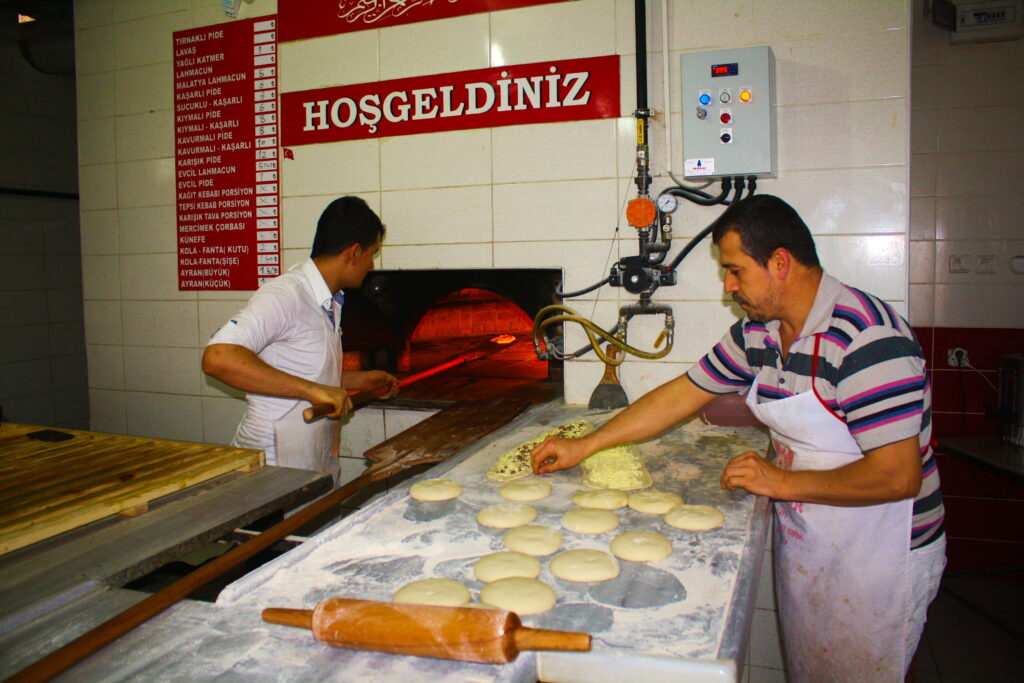 Turkish cuisine is a delightful blend of flavors, reflecting the country’s rich history and diverse influences. Here’s a breakdown of some of Turkey’s most beloved dishes:
Turkish cuisine is a delightful blend of flavors, reflecting the country’s rich history and diverse influences. Here’s a breakdown of some of Turkey’s most beloved dishes:
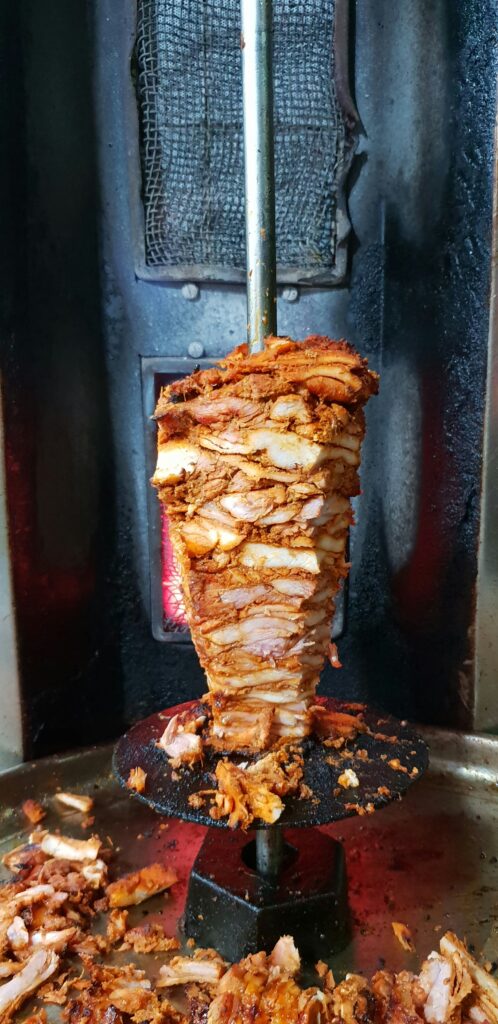
Meze:
Often referred to as the “soul” of Turkish cuisine, Meze is a selection of small plates served as appetizers. These can be hot or cold, vegetarian or meat-based, and offer a wonderful opportunity to sample a wide variety of flavors. Some popular Meze options include:
- Dolma: Stuffed grape leaves, peppers, or eggplants, often with rice, herbs, and ground meat
- Baba ghanoush: A roasted eggplant mash with tahini, olive oil, and spices
- Hummus: A creamy chickpea puree with tahini, olive oil, and lemon juice
- Cacik: A refreshing yogurt dip with cucumber, mint, and garlic
- Borekas: Savory pastries filled with spinach, cheese, or meat
Main Courses:
- Mantı: Turkish dumplings, similar to ravioli, filled with ground lamb or beef and served with yogurt, garlic sauce, and spices
- Kebab: Grilled meat dishes, come in many varieties including:
-
- Şiş Kebab: Marinated cubes of lamb or chicken grilled on skewers
- Döner Kebab: Shaved layers of seasoned meat stacked on a rotating spit and cooked
- Iskender Kebab: Thinly sliced döner meat served over pide bread (a flatbread) with tomato sauce, yogurt, and melted butter
- Lahmacun: Sometimes called “Turkish pizza,” a thin flatbread topped with seasoned ground lamb or beef, chopped vegetables, and herbs
- Menemen: A scrambled egg dish with tomatoes, onions, peppers, and spices
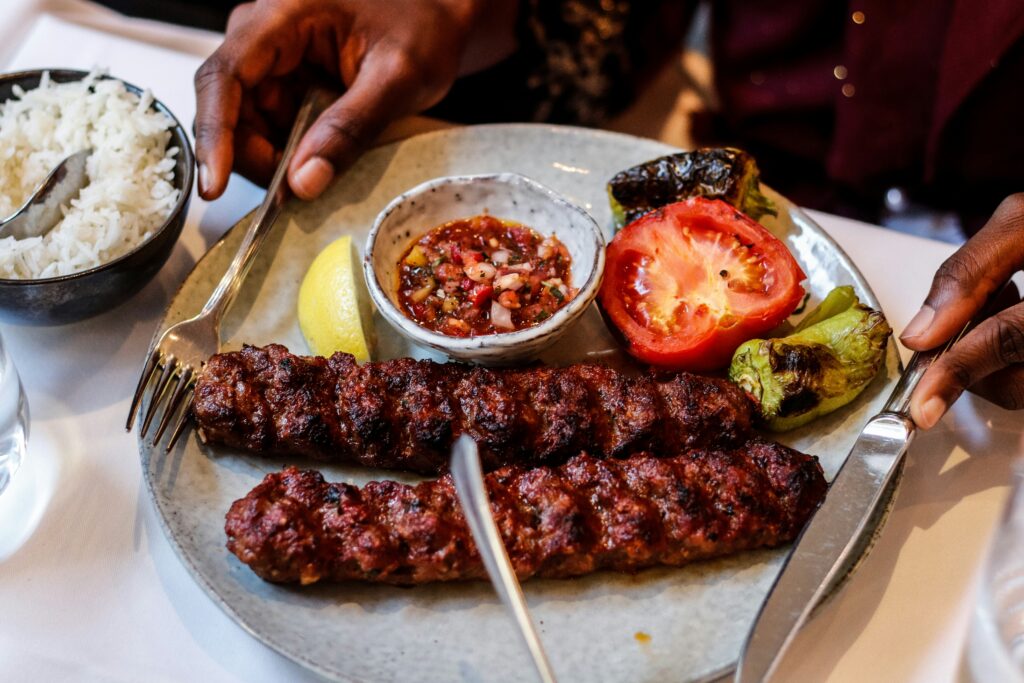
Desserts:
Turkish desserts are renowned for their sweetness and rich flavors. Some of the most popular include:
- Baklava: Layers of filo pastry filled with chopped nuts and sweetened with syrup
-
Künefe: Thin pastry filled with cheese, soaked in syrup, and topped with pistachios
- Lokum: Turkish delight, small, gelatinous candies flavored with rosewater, fruit, or nuts
Things to see and do in Turkey
Turkey, a transcontinental nation bridging Europe and Asia, boasts a rich tapestry of culture, history, and natural beauty. From the bustling streets of Istanbul to the turquoise waters of the Aegean coast, there’s something for every kind of tourist. Here’s a glimpse into the plethora of activities and leisure pursuits that Turkey has to offer:
Nature and Parks
- Beydağları Coastal National Park: Beydağları Coastal National Park, also known as Olympos Beydagları National Park, is a stunning protected area located in the Antalya Province of southern Turkey. Established in 1972, the park encompasses over 34,425 hectares (132.9 square miles) stretching along the Mediterranean coastline from Sarısu to Cape Gelidonya. This national park boasts a rich tapestry of natural beauty, combining soaring mountains with crystal-clear waters and vibrant ecosystems. The Beydağları Mountains, part of the Western Taurus Range, form the dramatic backdrop for the park. The park’s highest peak, Mount Tahtalı, offers opportunities for mountain climbing and paragliding for thrill-seekers. Hikers can explore the ancient trails that weave through the park, including a section of the Lycian Way, a long-distance trekking route that traverses the entire Mediterranean coast of Turkey. The park’s diverse landscape shelters a wealth of flora and fauna. Over 865 plant species thrive here, with 25 being endemic to the region. Visitors might encounter rare mammals like mountain goats, imperial eagles, and even Mediterranean monk seals basking on the shores. The park also incorporates the historical sites of Olympos, Phaselis, and Idyros, offering a glimpse into the region’s fascinating past.
- Yedigöller National Park: Yedigöller National Park, also known as Seven Lakes National Park, is a scenic getaway located in the northern part of Bolu Province, Turkey. Established in 1965, the park is categorized under IUCN protected area and is known for its stunning natural beauty, particularly the seven lakes formed by landslides. The park is a haven for nature lovers, boasting a rich profusion of plant life and diverse wildlife. Yedigöller National Park is easily accessible by road, located 152 kilometres from the Ankara-Istanbul highway via the Yenicaga road. During winter, the alternate route from Yenicaga-Mengen-Yazicik road is recommended. The park is roughly 42 kilometres north of Bolu. The park offers a variety of activities for visitors. Hikers can explore the numerous trekking paths that wind through the park’s forests, while campers can pitch tents or stay in bungalows or cabins. For those seeking a more relaxing experience, there’s a restaurant and scenic viewpoints like Kapankaya peak, offering breathtaking vistas of the lakes and surrounding landscape. The park is also known for its hot springs and winter sports facilities.
- Kaçkar Mountains National Park: Nestled in the northeastern part of Turkey, Kackar Mountains National Park boasts the title of being the highest and longest mountain chain bordering the Eastern Black Sea. Established in 1994, the park encompasses a vast area of over 52,970 hectares, making it a haven for nature enthusiasts. The dramatic Kackar Dağı, reaching an elevation of 3,937 meters, reigns supreme as the park’s highest peak. Glaciers clinging to the peaks contribute to the park’s rich biodiversity, feeding numerous crystal-clear lakes and carving stunning landscapes.
- The park is a trekker’s paradise, with routes ranging from easy paths to challenging climbs. The most popular trekking season is between June and September, although these months can also be misty and crowded. Hikers can choose between the Black Sea side, offering clear paths for easier treks, or the Coruh side, presenting a more challenging and rugged experience.
- For those seeking a comfortable basecamp, Ayder Plateau within the park provides the best facilities. Here, you’ll find cozy accommodations and relaxing thermal springs. Alternatively, designated camping areas are available in the town of Camlihemsin, located at the park’s fringe.
- Dilek Peninsula-Büyük Menderes Delta National Park: The Dilek Peninsula-Büyük Menderes Delta National Park is a stunning natural reserve located on Turkey’s Aegean coast, encompassing the entirety of the Dilek Peninsula and the vast delta of the Büyük Menderes River. Established in 1966, it’s one of the most important natural heritages in Turkey, boasting a diverse landscape that includes mountains, forests, wetlands, and idyllic beaches. The park covers an extensive area of 27,598 hectares, with the peninsula itself sprawling over 11,000 hectares. This park is a paradise for nature lovers. The diverse geography creates a haven for a rich variety of flora and fauna. Over 800 plant species thrive here, with 6 species endemic to the park and 18 unique to Turkey. Wildlife watching is a popular activity, with visitors hoping to spot wild boar, fallow deer, and over 250 species of birds, including cormorants, ospreys, and even flamingos. The Büyük Menderes Delta is a designated Important Bird Area due to the high number of migratory birds that visit.
- Uludağ National Park: Uludağ National Park, nestled in the Bursa province of Turkey, is a haven for nature enthusiasts and adventure seekers alike. Boasting the title of the highest mountain in the Marmara region, Uludağ (meaning “Great Mountain”) reaches an impressive height of 2,543 meters (8,343 feet). With its diverse landscapes, ranging from alpine meadows to rich forests, the park offers a variety of activities throughout the year. During the winter, Uludağ transforms into a popular winter sports centre, with ideal conditions for skiing due to snow cover lasting up to 178 days a year. The park boasts the longest cable car in the world, the Uludağ Teleferik, which stretches 8.2 kilometres (5.1 miles) and whisks visitors up the mountainside to stunning panoramic views. In the summer months, the park transforms into a hiker’s paradise. Lush forests teeming with diverse flora and fauna, including 104 endemic plant species, provide a picturesque backdrop for exploration. Camping is another popular option, with designated areas like Sarıalan Campground offering a chance to immerse oneself in the park’s natural beauty.
Culture and History:
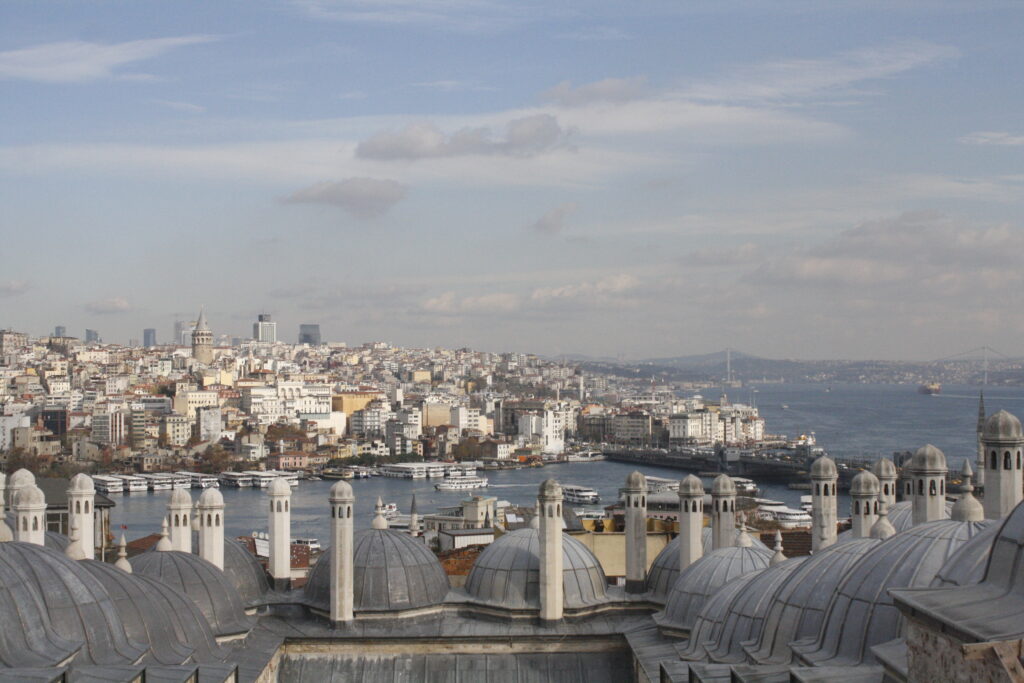
- Istanbul: Formerly Constantinople, Istanbul was the capital of the Ottoman Empire for centuries. The Hagia Sophia, a UNESCO World Heritage Site, is a architectural marvel that has served as a church, mosque, and museum throughout history .
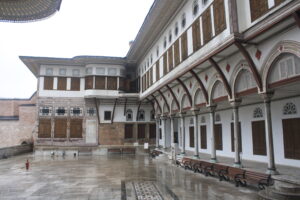 The Topkapi Palace: The Topkapı Palace, also known as the Seraglio, is a magnificent museum and library located in Istanbul, Turkey. It served as the administrative centre of the Ottoman Empire and the main residence of its sultans for over 400 years, from the mid-1460s to 1856. Construction began in 1459, just six years after the conquest of Constantinople by Sultan Mehmed the Conqueror, and the palace complex grew throughout the Ottoman era.
The Topkapi Palace: The Topkapı Palace, also known as the Seraglio, is a magnificent museum and library located in Istanbul, Turkey. It served as the administrative centre of the Ottoman Empire and the main residence of its sultans for over 400 years, from the mid-1460s to 1856. Construction began in 1459, just six years after the conquest of Constantinople by Sultan Mehmed the Conqueror, and the palace complex grew throughout the Ottoman era.
- Today, the Topkapı Palace is a UNESCO World Heritage Site and one of the most popular tourist attractions in Istanbul. It is a sprawling complex that encompasses four main courtyards, numerous buildings, and lush gardens. Visitors can explore the imperial kitchens, the harem, the treasury, and the Hall of Holy Relics, which houses important Islamic artifacts such as the mantle of the Prophet Muhammad. The palace also boasts an impressive collection of Ottoman art, including ceramics, calligraphy, and jewellery.
 Ephesus: This ancient Greek city, nestled near the Aegean coast, was a major trade centre and religious hub. Explore the ruins of the Library of Celsus,
Ephesus: This ancient Greek city, nestled near the Aegean coast, was a major trade centre and religious hub. Explore the ruins of the Library of Celsus,
- The Temple of Artemis: The Temple of Artemis, also known as the Artemision, was a Greek temple dedicated to the goddess Artemis, a protector of the Ephesians. Located near the ancient city of Ephesus, which is present-day Selçuk, Turkey, the temple was one of the Seven Wonders of the Ancient World. Construction of the Temple of Artemis began around the 8th century BCE and went through several iterations. The most famous version, funded by King Croesus of Lydia in the 6th century BCE, was a marvel of Ionic architecture. This temple boasted an impressive 127 columns, each reaching 60 feet in height, a massive footprint exceeding 350 by 180 feet, and housed exquisite works of art. Unfortunately, the temple had a turbulent history. A man named Herostratus burned the temple down in 356 BCE in a misguided attempt at fame. The Ephesians rebuilt the temple even grander than before, but it wasn’t spared destruction. The temple was damaged by invading Goths in 262 CE and finally torn down by a Christian mob in 401 CE. Today, only the foundations and scattered fragments remain at the site, a testament to the temple’s once glorious presence. Despite its physical absence, the Temple of Artemis continues to capture the imagination, serving as a powerful symbol of ancient Ephesus and its enduring legacy.
 Göbekli Tepe: Göbekli Tepe, which translates to “Potbelly Hill” in Turkish, is a fascinating Neolithic archaeological site located in southeastern Turkey, roughly 15 kilometres northeast of Şanlıurfa. This area was inhabited from circa 9500 to at least 8000 BCE, during the Pre-Pottery Neolithic period. The site is most famous for its large circular structures that contain massive T-shaped stone pillars, some reaching up to 5.5 meters in height and weighing 16 tons! These megaliths are the oldest known monumental structures in the world, predating Stonehenge by an impressive 6,000 years. Many of the pillars are decorated with reliefs of wild animals, such as lions, bulls, and foxes, as well as human figures. These depictions provide valuable insights into the belief systems and artistic expression of this early civilization. The purpose of Göbekli Tepe remains a mystery, but it is believed to have been a place of religious significance. Göbekli Tepe was discovered in 1995 by German archaeologist Klaus Schmidt. Less than 5% of the site has been excavated so far, leaving much to be uncovered about this captivating place and the people who built it. Göbekli Tepe was designated a UNESCO World Heritage Site in 2018 in recognition of its exceptional historical and archaeological significance.
Göbekli Tepe: Göbekli Tepe, which translates to “Potbelly Hill” in Turkish, is a fascinating Neolithic archaeological site located in southeastern Turkey, roughly 15 kilometres northeast of Şanlıurfa. This area was inhabited from circa 9500 to at least 8000 BCE, during the Pre-Pottery Neolithic period. The site is most famous for its large circular structures that contain massive T-shaped stone pillars, some reaching up to 5.5 meters in height and weighing 16 tons! These megaliths are the oldest known monumental structures in the world, predating Stonehenge by an impressive 6,000 years. Many of the pillars are decorated with reliefs of wild animals, such as lions, bulls, and foxes, as well as human figures. These depictions provide valuable insights into the belief systems and artistic expression of this early civilization. The purpose of Göbekli Tepe remains a mystery, but it is believed to have been a place of religious significance. Göbekli Tepe was discovered in 1995 by German archaeologist Klaus Schmidt. Less than 5% of the site has been excavated so far, leaving much to be uncovered about this captivating place and the people who built it. Göbekli Tepe was designated a UNESCO World Heritage Site in 2018 in recognition of its exceptional historical and archaeological significance. Cappadocia: Cappadocia’s otherworldly landscape, characterized by “fairy chimneys” (cone-shaped rock formations), was once home to troglodyte settlements.
Cappadocia: Cappadocia’s otherworldly landscape, characterized by “fairy chimneys” (cone-shaped rock formations), was once home to troglodyte settlements.- Kaymakli: Kaymakli Underground City is an ancient multi-level underground city carved out of volcanic rock in Kaymakli, Turkey. The city extends downward for eight stories, although only four of these levels are open to the public. This fascinating historical site is estimated to have housed up to 3,500 people and contains a maze of tunnels, chambers, and rooms. The soft volcanic rock of Cappadocia provided the perfect medium for carving out these underground cities. Early Christians used the underground chambers as places of worship and community gatherings, while the lower levels were used for storage. The ventilation system is quite ingenious, with a series of shafts that brought fresh air down to the many levels of the city. The Kaymakli Underground City is a popular tourist destination and offers a glimpse into a unique way of life. It is one of the best-preserved underground cities in Cappadocia and is sure to fascinate visitors of all ages.
- Derinkuyu: Derinkuyu, Turkey is home to an incredible marvel of ancient engineering – an enormous underground city! Located in the Nevşehir Province of Cappadocia, Derinkuyu itself is a small town on the surface. But beneath it lies a multi-level subterranean metropolis carved out of soft volcanic rock. This underground city, known as Derinkuyu Underground City, is the largest excavated one in all of Turkey and could shelter up to 20,000 people along with their livestock and supplies. Imagine a whole town, eight stories deep (that’s roughly the same depth as a 25-story building!), complete with living spaces, stables, storage rooms, churches, and even a ventilation system.The exact origins of Derinkuyu are shrouded in a bit of mystery. The soft volcanic rock in the Cappadocia region made it easy to carve out these underground spaces, and evidence suggests people have been using them for millennia. The city was most likely developed and heavily used during the Byzantine era (between 330 and 1453 AD) as a refuge from invaders. Its cleverly designed ventilation shafts and rolling stone doors helped keep inhabitants safe.
- The Byzantine cave churches of Goreme:. Nestled in the heart of Cappadocia, Turkey, the Byzantine cave churches of Göreme are a breathtaking marvel carved into volcanic rock. For centuries, between the 4th and 10th centuries AD, Christian monastic communities meticulously carved out churches, monasteries, and living spaces from the soft volcanic tuff. The resulting complex is a UNESCO World Heritage Site, renowned for its stunning architecture and vibrant frescoes depicting biblical scenes and saints.The most concentrated collection of cave churches is found in the Göreme Open Air Museum, an easily accessible site showcasing dozens of churches. One of the most famous is the Dark Church (Karanlık Kilise), named for its minimal natural light that has helped preserve its vivid frescoes for centuries. Another highlight is the Buckle Church (Tokalı Kilise), the largest cave church in Göreme, adorned with impressive depictions of Jesus Christ, saints, and geometric patterns. Beyond the Open Air Museum, numerous other cave churches are scattered throughout the Göreme valleys. Exploring these hidden gems offers a chance to witness the vast scale of monastic life in Cappadocia. If you’re planning a visit, be sure to wear comfortable shoes, as navigating the cave churches often involves climbing stairs and uneven terrain. A guided tour can provide valuable insights into the history, symbolism, and artistic techniques behind these remarkable structures.
- Pergamon: Pergamon, also sometimes referred to as Pergamum, was an ancient Greek city located in modern-day Turkey. Pergamum flourished during the Hellenistic period (323-30 BCE) under the rule of the Attalid dynasty, becoming a major intellectual and cultural centre. The city was strategically situated on a prominent hill overlooking the Caicus River, offering a defensible position and a commanding view of the surrounding area. Today, Pergamon is an archaeological site located near the modern town of Bergama, in the Izmir province of Turkey. The ancient city is renowned for its impressive remains, including the steeply inclined Theatre, one of the steepest ancient theatres in the world, and the Pergamon Altar, a monumental altar dedicated to Zeus. Pergamon was also home to a famed library, rivaled only by Alexandria in its time, though sadly, little remains of the library itself. Pergamon’s rich history and archaeological significance make it a popular destination for travelers interested in the ancient world. The site is a UNESCO World Heritage Site, recognized for its outstanding universal value as a multi-layered cultural landscape.
Thrills and Entertainment
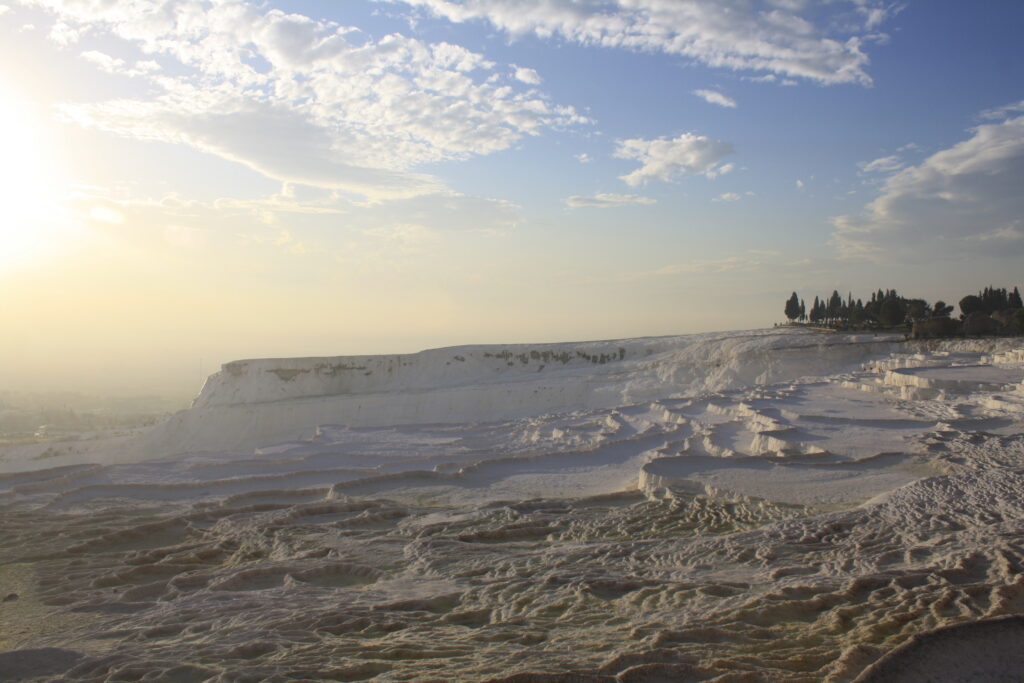
- Pamukkale: Pamukkale, meaning “cotton castle” in Turkish, is a natural site in Denizli Province in southwestern Turkey. It’s famous for the dazzling white travertine terraces that cascade down a hillside overlooking the valley. These terraces are formed by mineral-rich thermal spring water that has been flowing down the hillside for millennia, creating a truly unique and breathtaking landscape. Hierapolis, an ancient Greco-Roman city, sits atop the travertine cliffs of Pamukkale. Founded in 190 BC, the city was a renowned spa centre in the Roman era. Today, you can explore the ruins of the baths, temples, theatres, and a necropolis with sarcophagi that stretch for over 2 kilometres. Pamukkale was inscribed as a UNESCO World Heritage Site in 1988. Visitors can walk barefoot on the travertine terraces, soaking in the otherworldly beauty of the place. However, it’s important to be aware that swimming in the pools is no longer allowed to help preserve the travertine.
- Paragliding in Oludeniz: Paragliding in Oludeniz, Turkey is an incredible experience that allows you to soar over the stunning landscape of the Blue Lagoon and Babadag Mountain. Oludeniz is reputedly the best site in Europe, if not the world, to fly paragliders due to its ideal weather conditions and thermals. You can take a tandem paragliding flight with a professional pilot, so no prior experience is necessary. Flights typically last between 25-30 minutes and take you up to 6,500 feet in the air. From this height, you’ll have breathtaking views of the lagoon, beach, and surrounding mountains. Many companies offer paragliding in Oludeniz, so be sure to shop around to find a reputable company with experienced pilots.
Festivals and Events
- Istanbul Tulip Festival (April-May): Every spring, Istanbul bursts into color with the Tulip Festival. Millions of tulips of all shapes and sizes bloom across the city, transforming parks, squares, and even traffic circles into vibrant floral displays. The festival officially runs through April, but depending on the weather, you might catch the tulips in bloom from late March to early May. The best places to see the tulips include Emirgan Park, Yıldız Park, and Gülhane Park, but wherever you roam in Istanbul during this springtime celebration, you’re sure to be dazzled by these beautiful flowers.
- Kırkpınar Oil Wrestling Festival (June): the Kirkpinar Oil Wrestling Festival is a celebration of tradition and strength. Wrestlers, called pehlivans, compete for glory by grappling each other after being covered in olive oil. This unique wrestling style is believed to date back thousands of years. The festival itself is a week-long event filled with music, food, and local crafts, culminating in a three-day wrestling tournament. Interestingly, the Kirkpinar festival holds the Guinness World Record for the longest continuously running sporting event in the world, dating back to the 1360s.
- Cappadocia Balloon Festival (July): Cappadocia in Turkey hosts a spectacular hot air balloon festival. The event typically takes place in either July or August, lasting for several days. During the festival, over 150 hot air balloons take to the skies, creating a breathtaking scene of colorful dots against the backdrop of Cappadocia’s unique rock formations. People come from all over the world to witness this magical event, and even participate in rides that soar above the valleys and historical sites. It’s a truly unforgettable experience.
- International Aspendos Opera and Ballet Festival (various dates throughout summer): The International Aspendos Opera and Ballet Festival is an annual event held in Aspendos, Turkey. It takes place in the Roman amphitheater, which is one of the most well-preserved ancient theaters in the world. The festival features performances of operas and ballets by world-renowned artists. It is a popular event that attracts visitors from all over the world. The festival was established in 1994 and has been held annually since then. It is typically held in June and July, but the exact dates can vary from year to year. In 2023, the festival was held from September 4 to 21.
- Rock’n Coke (various dates throughout summer): Rock’n Coke was once Turkey’s biggest music festival. It ran for several years and was known for its mix of international and Turkish rock bands. The festival even featured some huge names like Linkin Park, The Cure, and The Prodigy! It was a two-day event held at the Hezarfen Airfield in Istanbul. Sadly, the festival hasn’t been held since 2017.
- Mesir Paste Festival (May): The Mesir Paste Festival is a celebration held in Manisa, Turkey, to remember the recovery of Hafsa Sultan, the mother of Sultan Suleiman the Magnificent. The festival centres around a special paste called Mesir Macunu, which was supposedly invented to cure her illness. Every year, from March 21st to 24th, the paste is traditionally prepared using 41 herbs and spices. The highlight of the festival is the throwing of small, wrapped pieces of Mesir paste from the top of the Sultan Mosque. Thousands gather to catch these pieces, believing it will bring them good luck. The festival is a vibrant cultural experience that blends history, tradition, and a touch of friendly competition.
- National Sovereignty and Children’s Day (April 23): Every April 23rd, Turkey celebrates National Sovereignty and Children’s Day. It’s a unique double celebration. On this day in 1920, the Turkish Grand National Assembly was founded, marking a big step towards creating an independent Turkish Republic. Nine years later, it was dedicated to children as well, making Turkey the first country in the world to have an official Children’s Day. So the day honors both the birth of Turkish democracy and the future – its children. There are parades, performances, and special events for children in schools, and even a symbolic ceremony where children get to take seats in parliament for a day.
- Republic Day (October 29): The Republic Day in Turkey is a national holiday that commemorates the founding of the Republic of Turkey on October 29th, 1923. It’s a major celebration marked by parades, military displays, fireworks, and speeches. People often wear red and white, the colours of the Turkish flag, and gather for festivities. It’s a day to remember the country’s transformation into a modern republic and celebrate its national identity.
Living in Turkey
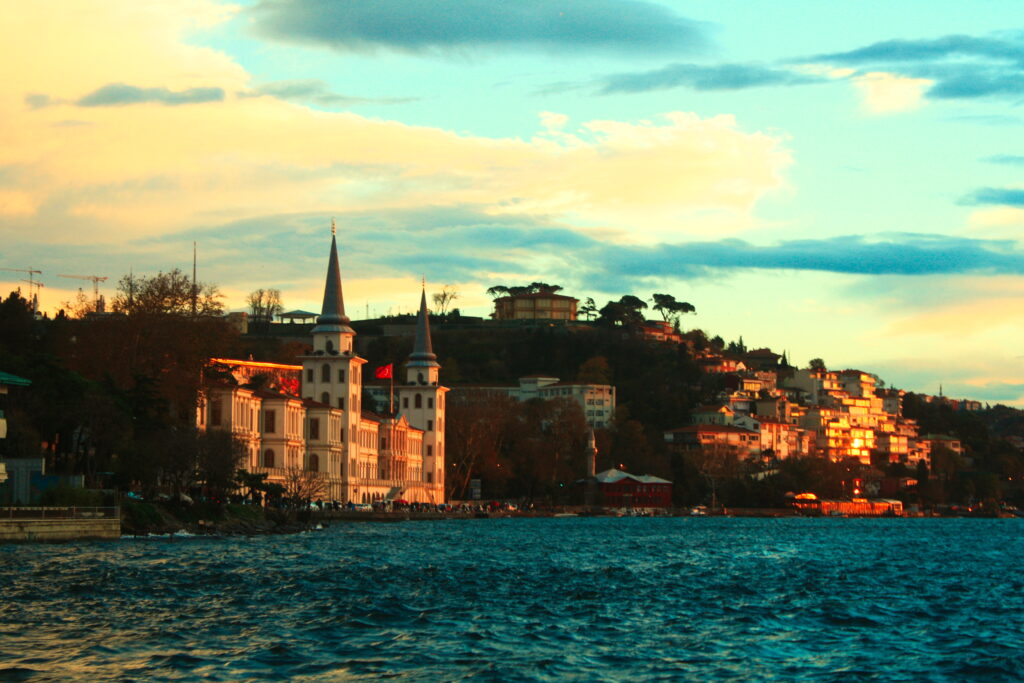
Housing and Living Cost
The cost of living in Turkey varies depending on location and lifestyle, but overall it’s considered quite affordable compared to many Western countries. Housing is a major factor, with Istanbul being the most expensive city. Renting a one-bedroom apartment in the city centre can range from ₺3,000 to ₺5,500 (US$96-176) monthly while finding similar options outside the centre is possible for ₺2,000-₺3,500 (US$64-112). Other major cities like Ankara and Izmir are more affordable, with rents generally starting around ₺2,000 (US$64). Beyond rent, utilities are relatively inexpensive, averaging around ₺500 (US$65) per month for a family of four. Daily living expenses like groceries and transportation are also lower than Western averages. To give you a better idea, a single person can comfortably live in Turkey for around ₺16,500 (US$514) per month excluding rent, while a family of four might expect to spend around ₺59,000 (US$1,833) not including housing.
Health and Education Facilities
Turkey offers a well-developed system for both healthcare and education. The healthcare system is comprised of public hospitals, university hospitals, and private institutions. Public hospitals provide primary care through a family medicine system, while university hospitals and private facilities handle more specialized cases. Medical education in Turkey is also noteworthy, boasting prestigious universities with programs in medicine, dentistry, and pharmacy. This strong foundation in medical training contributes to a skilled workforce and advancements in medical research. On the education side, Turkey emphasizes health education within schools, with the Ministry of National Education collaborating with the Ministry of Health to deliver a curriculum focused on areas like nutrition, hygiene, and mental health.
Investing in Turkey
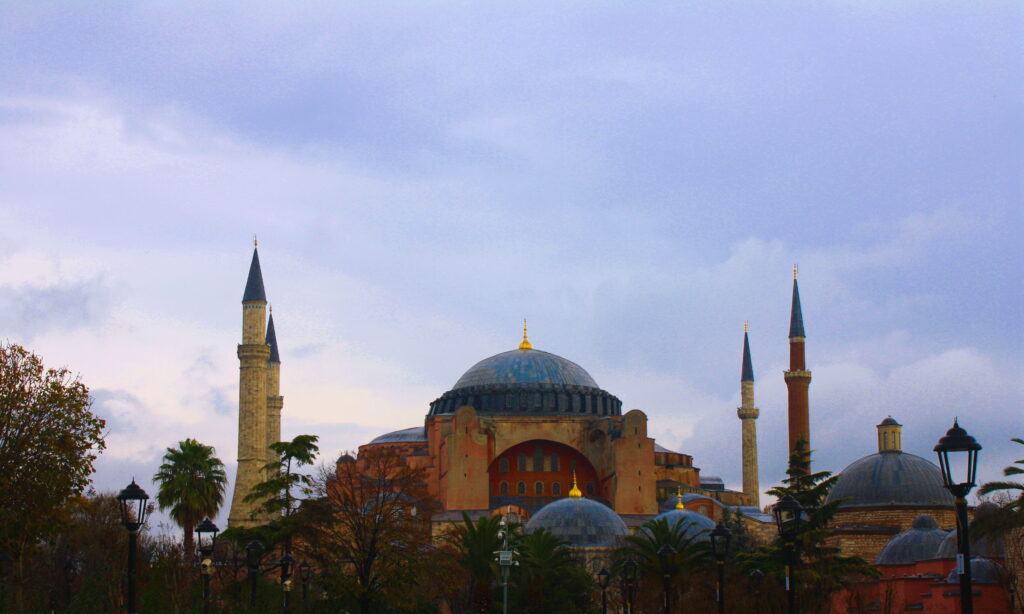
Economy in Turkey
Turkey boasts a complex and interesting economy. Classified as an upper-middle-income, mixed-market emerging economy by the IMF, Turkey is also a member of prestigious groups like the OECD and G20. The country has experienced impressive growth in recent years, ranking 17th largest globally by nominal GDP in 2023. This economic strength is fueled by a robust services sector, a growing industrial base, and its status as a popular tourist destination. However, Turkey also faces challenges. High inflation and a depreciation of the Turkish Lira have caused some concern. The government is working to address these issues and promote long-term stability.
Political Overview
Turkey’s political landscape is a multiparty system within a democratic parliamentary republic. The President holds significant power, acting as both head of state and head of government. This structure emerged from a 2017 constitutional reform. Despite the democratic framework, some raise concerns about limitations on free speech and political participation. The country has a long history of military involvement in politics, though civilian rule has been the norm since the 1950s.
The Legal System in Turkey
Turkey’s legal system is based on civil law, meaning statutes and codes form the primary source of law, unlike common law systems that rely heavily on judicial precedent. Here’s a breakdown of key aspects:
Sources of Law
Primary Sources:
- Constitution (Anayasa): The supreme law of Turkey, establishing the fundamental legal principles and framework for all other laws. The Constitution embodies the concept of supremacy of the constitution, meaning all other legal sources must comply with it.
- Legislation (Kanunlar): Laws enacted by the Turkish Grand National Assembly (TBMM) on various matters. These laws cover a broad range and provide specific legal rules.
- International Treaties (Uluslararası Anlaşmalar): Treaties ratified by Turkey become part of its legal system and take precedence over national laws if there’s a conflict.
- Regulations (Tüzükler): Issued by the Council of Ministers or relevant ministries to expand on existing laws and provide more detailed implementation guidelines.
Secondary Sources:
- Customary Law (Örf ve Adet Hukuku): Unwritten rules and practices followed by a community for a long time. While not a prominent source, customary law can be applied in the absence of written law provisions, but only if proven to be long-standing and not contradicting existing legislation.
- Case Law (Yargı Kararları): Decisions of higher courts, particularly the Court of Cassation (Yargıtay), can be persuasive and guide lower courts in similar cases. However, unlike common law systems, judicial precedent isn’t a binding source of law in Turkey.
- Legal Doctrine (Doktrin): The writings of legal scholars can offer valuable insights and interpretations of the law. Although not a direct source of law, legal doctrine can influence judicial decision-making and legislative processes.
Court System in Turkey
- Judicial Courts (Ordinary Courts): Handle civil and criminal matters involving individuals and private entities.
- Peace Courts (Sulh Ceza Mahkemeleri): Lowest level courts, handling minor civil and criminal cases with a single judge.
- Civil Courts of First Instance (Asliye Hukuk Mahkemeleri): Basic courts for most civil cases, with broader jurisdiction than Peace Courts.
- Regional Courts of Justice (Bölge Adliye Mahkemeleri): Higher courts handling appeals from Peace and Civil Courts, with panels of three judges.
- Court of Cassation (Yargıtay): Highest court of appeals for the judicial court system, reviewing decisions for legal errors, not factual findings.
- Administrative Courts: Deal with disputes between individuals or businesses and the government.
- Administrative Courts: First instance courts for administrative disputes, with a presiding judge and members.
- Regional Administrative Courts: Hear appeals from Administrative Courts, with panels of judges.
- Council of State (Danıştay): Highest court of appeals for the administrative court system.
- Military Courts: Handle criminal cases involving military personnel and certain national security matters.
- Military Courts of First Instance: Lower courts for military cases.
- Military Court of Cassation: Highest court of appeals for the military court system.
- High Military Administrative Court: Highest court for administrative disputes involving the military.
Key Characteristics of Law in Turkey
- Civil Law System: Turkey’s legal system is rooted in the civil law tradition, also known as the continental law tradition. This means its primary source of law is codified statutes, rather than judicial precedent as in common law systems (like the US or UK). Turkish law is heavily influenced by Swiss Civil Code and other European legal codes. Courts primarily interpret and apply these codes, with less emphasis on past rulings to set legal principles.
- Evolving Democratic Landscape: Turkey’s legal system is undergoing a complex evolution alongside its democratic system. The historic influence of the executive branch on the judiciary is a point of ongoing discussion. While Turkey has made strides towards strengthening judicial independence, concerns persist regarding government influence on judicial appointments and rulings.
Unique Aspects of The System in Turkey
- A blend of Civil Law and Ottoman Legacy: Turkey’s legal system is primarily civil law based, meaning codified statutes are the main source of law. This influence comes from continental Europe, particularly Switzerland. However, Turkish law also retains elements from the Ottoman legal system, which was influenced by Islamic law. This creates a unique blend of legal traditions.
- Harmonization with the European Union: Turkey, as a candidate for EU membership, has undertaken reforms to harmonize its legal system with EU law. This means adopting EU regulations and directives in various areas, bringing Turkish law closer to European standards.
- Role of the Judge: Compared to some common law systems, Turkish judges have a more active role in interpreting the law. They can play a part in developing legal principles through their decisions.
- Constitutional Court: Turkey has a strong Constitutional Court that plays a vital role in ensuring the constitutionality of laws. Its decisions are binding on all courts and institutions.
The Republic of Turkey Prime Ministry Investment Support and Promotion Agency (ISPAT)
The Republic of Turkey Prime Ministry Investment Support and Promotion Agency (ISPAT), now known as the Republic of Türkiye Investment Office, was the official organization tasked with attracting foreign direct investment (FDI) to Turkey. Established in 2007 and reporting directly to the Prime Minister (now the President), ISPAT offered a comprehensive suite of services to investors throughout the investment lifecycle, from initial market research and site selection to navigating legal procedures and obtaining permits. ISPAT operated with a multinational team of professionals and a network of local consultants, ensuring investors receive assistance in their preferred language. Their focus was on high-technology, value-added investments that would create jobs and contribute to Turkey’s economic development. While ISPAT is no longer the primary organization, its successor, the Republic of Türkiye Investment Office, continues to fulfill this mission.
Investment
Establishing a Company in Turkey as a Foreigner
Turkey offers a welcoming environment for foreign entrepreneurs. Here’s a roadmap to help you establish your company as a foreign investor:
- Choosing Your Business Structure:
-
- Limited Liability Company (LLC): Popular choice for foreigners due to its simple structure and limited shareholder liability.
- Joint Stock Company (JSC): More complex structure suited for larger businesses seeking to raise capital through public offerings.
- Pre-Registration Steps:
-
- Obtain Tax Number: Visit the local tax office with your passport and application to get a potential tax identification number.
- Company Name Approval: Check for name availability through the online MERSİS system (https://mersis.ticaret.gov.tr/).
- Company Registration:
-
- Prepare Company Articles: Outline company name, purpose, capital, and management structure. Have them translated and notarized by a Turkish notary.
- Open Corporate Bank Account: Deposit the minimum required capital (around TRY 10,000 for LLCs).
- Register with Trade Registry: Submit the prepared documents, application form, and bank deposit receipt to the Trade Registry Directorate.
- Additional Considerations:
-
- Residence Permit: Depending on your situation, you might need a work or residence permit. Consult immigration authorities for details.
- Post-Registration: Register with the relevant Chambers of Commerce and Industry. Obtain necessary licenses and permits for your specific industry.
Reason for Investing in Turkey
Turkey’s unique blend of strategic location, economic growth, and a youthful, skilled workforce makes it a highly attractive option for foreign investors. Here’s a closer look at some of the key reasons to consider Turkey for your next investment venture:
- Robust Economy: Boasting one of the fastest-growing economies globally, Turkey offers significant potential for investors. Over the past two decades, the country has seen an impressive average annual GDP growth rate of 5.4%.
- Large and Accessible Markets: Turkey itself boasts a sizeable domestic market, but its true advantage lies in its access to a wider region. Free Trade Agreements grant investors easy entry to markets encompassing over 1 billion consumers.
- Strategic Location: Forming a bridge between Europe and Asia, Turkey offers unparalleled geographic advantages. This makes it an ideal location for establishing regional headquarters, with seamless global connectivity by land, air, and sea.
- Favorable Demographics: With a young and dynamic population, half of which is under 33.5 years old, Turkey presents a vibrant market with a strong consumer base and a future-oriented workforce.
- Skilled and Competitive Labor Force: Turkey offers a pool of talented and well-educated professionals at competitive costs. The government actively invests in education, ensuring a steady stream of skilled labor to meet industry demands.
Additional factors that make Turkey an attractive investment destination include:
- Government Incentives: The Turkish government actively encourages foreign investment by offering a range of lucrative incentives, tailored to different investment profiles.
- Continuous Reform Process: Turkey is committed to ongoing economic and regulatory reforms, fostering a business-friendly environment.
- Liberal Investment Climate: Foreign investors enjoy a liberal investment climate with minimal restrictions on entry and operations.
- Advantageous R&D Ecosystem: The government actively supports research and development, providing a fertile ground for innovation-driven businesses.
- Investment Opportunities
- Real Estate: A perennial favorite, Turkish real estate offers potential for high returns, with a thriving market particularly in major cities like Istanbul. The government’s citizenship by investment program, starting at $400,000 in real estate, further adds to the sector’s appeal.
- Tourism & Hospitality: Capitalize on Turkey’s rich cultural heritage and natural beauty. The tourism industry is a major contributor to the economy, offering opportunities in hotels, resorts, and adventure tourism ventures.
- Information Technology & Startups: Turkey’s IT sector is flourishing, attracting global attention. Istanbul is a hub for startups, with exciting prospects in software development, fintech, e-commerce, and various emerging technologies.
- Other Promising Sectors: Consider opportunities in manufacturing (textiles, IT & tech), healthcare, agriculture, energy, and logistics, all benefiting from Turkey’s strategic location and trade agreements.
Turkish Mega Projects

Turkey has undertaken a series of ambitious mega projects in recent years, aiming to modernize its infrastructure, boost its economy, and solidify its position as a regional hub. These large-scale endeavors span various sectors, including transportation, energy, and finance. Here’s a breakdown of some of the most prominent projects:
Transportation:
- Istanbul Airport (Third Airport): One of the world’s largest airports by capacity, Istanbul Airport serves as a major international gateway. This multi-phased project boasts advanced facilities and aims to handle a staggering 200 million passengers annually upon completion.
- Kanal Istanbul: An ambitious proposal for a man-made canal connecting the Black Sea to the Sea of Marmara. This project, still under debate, has the potential to significantly alter shipping routes but also faces environmental concerns.
- High-Speed Rail Network: Turkey’s high-speed rail network is rapidly expanding, connecting major cities like Ankara, Istanbul, and Izmir. This development aims to reduce travel times and improve overall connectivity.
- Bridge Projects: Several impressive bridge constructions have bolstered Turkish infrastructure. These include the Yavuz Sultan Selim Bridge (spanning the Bosphorus), the Osmangazi Bridge (connecting the Gulf of Izmit to the Marmara Sea), and the recently opened 1915 Canakkale Bridge (the first bridge to cross the Dardanelles).
Energy:
- Akkuyu Nuclear Power Plant: This under-construction plant aims to diversify Turkey’s energy sources and reduce dependence on imports. The project has drawn attention due to its large scale and the use of nuclear technology.
- Southeast Anatolia Projects (GAP): A large-scale regional development project encompassing irrigation, dams, and hydropower plants. GAP targets economic growth and agricultural development in southeastern Turkey.
Finance:
Istanbul Finance Centre: An ongoing project to create a financial hub in Istanbul, attracting international financial institutions and businesses. This initiative aims to solidify Istanbul’s position as a key financial centre in the region.
Immigration
Turkey offers a welcoming environment for foreign investors and foreigners seeking residency. There are two main routes to consider:
Investor Immigration:
This option grants you a residence permit with the potential path to citizenship through investment. Here are the key highlights:
- Minimum Investment:
- Fixed Capital: Invest a minimum of USD 500,000 in a company and maintain it for at least three years.
- Real Estate: Purchase property valued at minimum USD 400,000 and hold it for at least three years. You cannot sell the property during this period.
- Other Options: Investing in government bonds or investment funds for a minimum of three years may also qualify (check current regulations for details).
- Benefits:
- Fast-track residency permit application process.
- Eligibility to apply for Turkish citizenship after three years of holding the investment.
- Your spouse and dependent children can also be included in the application.
Residence Permit:
If you don’t intend to invest the minimum amounts, you can still obtain a residence permit in Turkey. Here are some common options:
- Short-Term Permit: Valid for up to two years, with the possibility of renewal.
- Long-Term Permit: Valid for one year and renewable, often obtained for work purposes or marriage to a Turkish citizen.
Tax for Foreign Investors
Foreign Investors:
- Tax Residency: Turkey taxes residents on their worldwide income. Residency is established if you’re domiciled in Turkey or stay for more than six months in a calendar year.
- Corporate Tax: Companies registered in Turkey pay corporate income tax on their global income. The current rate is 20%.
- Holding Company Regime: For qualifying companies, a holding company regime offers tax benefits, including exemption from corporate tax on certain dividends and capital gains.
- Withholding Tax: Dividends paid to foreign investors are generally subject to a 15% withholding tax, although Double Taxation Treaties (DTTs) can reduce this rate.
Foreign Employees:
- Tax Residency: Similar to investors, residency determines tax liability. Resident foreign employees pay income tax on their global income.
- Income Tax: Turkey applies a progressive income tax system, with rates ranging from 15% to 40% for 2023.
- Source of Income: Foreign employees are taxed on income earned in Turkey or paid from Turkey, even if the work is performed elsewhere. DTTs may provide exemptions.
- Liaison Offices: Employees of liaison offices (representative offices) established in Turkey with specific purposes may be exempt from income tax under certain conditions, such as receiving payment in foreign currency from abroad.
Additional Considerations:
- VAT (Value Added Tax): A 18% VAT is applied to most goods and services in Turkey.
- Stamp Duty: A small tax is levied on various documents used in business transactions.
- Social Security: Foreign employees may be subject to social security contributions depending on their employment situation.
Turkey Travel Business Assistance
Are you planning to move your business to Turkey or open up Turkey as a new market? Perhaps there is a conference in Turkey you need to attend and you need some help. We are here for your Turkey Travel Business Assistance.
